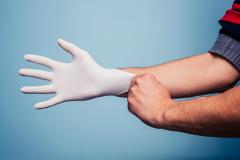Biosecurity Suggestions: Precautions for Zoonotic Disease Transmission

Protecting veterinary clinic staff from the transmission of zoonotic diseases can be accomplished by following biosecurity guidelines.
Transmission Risks
Since zoonotic disease pathogens can be directly passed through contact with an infected animal, and indirectly passed through contact with the infected animal’s environment, any time a staff member examines, treats, or cleans up after a sick animal they increase their risk of infection.
A risk assessment for veterinary staff should be conducted for each patient that presents with a zoonotic disease. Factors to consider would include:
- Level of risk
- Disease characteristics
- Vaccination status of staff
- Possibility of exposure
- Seriousness of possible exposure
Transmission-based Precautions
When an animal is suspected of being infected with an infectious disease, additional steps should be taken to prevent its spread. Establishing biosecurity guidelines help to define steps that reduce the risk of acquiring a zoonotic disease. These precautions may include the following procedures.
Isolation of AnimalIsolating an animal involves establishing a waiting room that is safe for clients, patients, and employees.
- Potentially infectious animals should be
- Moved into and out of clinic through a separate entry/exit site that does not take them through waiting area
- They should then be placed directly in a dedicated examination room
- The entry/exit site and examination room should be thoroughly decontaminated once animal leaves
- The infectious animal should be clearly identified to staff in case any other precautions need to be taken.
Veterinary practices should have an isolation room that can be prepared for infected patients. This room should:
- Be easily emptied of non-essential equipment
- Be easily cleaned and disinfected
- Have an established ventilation system that:
- exhausts to the outside of the building
- is maintained regularly
- Equipment and materials needed should be dedicated to the room and never used elsewhere
- Use of disposable articles is preferable
- Access to this room should be limited and a sign-in sheet kept to record individual contacts with the infectious animal
If shoe coverings are not used and disposed of, install a footbath:
- Place inside room to be used just before departing
- Change daily
Clean gowns, overalls, gloves, masks, eye protection
- Should be worn when handling an animal with an infectious disease
- Gloves, masks should be discarded
- Unless contaminated, the rest of the personal equipment may be re-used with patient, remaining in the isolation room
- Protective equipment should be cleaned and disinfected after each patient
- Equipment should be considered contaminated, and then be bagged, transported, disinfected, or disposed of according to the disease
In order to reduce the risk of infection, the only staff members who should be near the patient are the ones who need to be involved in its care.
Biosecurity Recommendations for OwnersVeterinarians and staff need to establish a dialogue that creates owner awareness of the serious nature and responsibilities of having a zoonotic disease infected animal, and of the steps they need to follow to stop the spread of disease. The discussion should include such topics as:
- How disease spreads
- Cleaning/disinfecting steps to follow after contact with animal
- Explanation of an isolation or quarantine area
- Explanation of the need to isolate sick animals or animals in contact with sick animals
- Disinfecting requirements for equipment and the animal’s room
- Stopping movement of animals on/off property.
Sources:
http://www.cdc.gov/niosh/topics/veterinary/biological.htmlhttp://www.ava.com/au/biosecurity-guidelines
Careers
Are you looking for a place to let your talents shine? At Covetrus, we help our practitioner customers better serve their patients and take pride in providing the best customer experience possible. Search our open positions to see our available opportunities.
Newsletter
Stay current with what’s going on with Covetrus, subscribe to receive our newsletter and email communications. Subscribers will receive the latest information in practice management, sales and marketing, animal health, and more.


Leave a comment